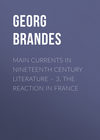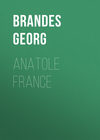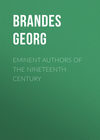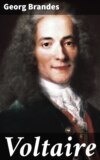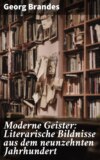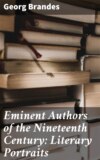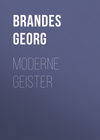Loe raamatut: «Main Currents in Nineteenth Century Literature – 3. The Reaction in France», lehekülg 10
In the sketch entitled Kreisler's musikalisch poetischer Klub, he gives to the characteristic qualities of certain notes the names of colours, and thereby produces a picture of a connected series of mental impressions. He had the keen perception peculiar to certain delicately organised, nervous temperaments, of the relationship which undoubtedly exists between sounds and colours.
As an example of Hoffmann's advance on Tieck's attempts to express pure music in words, note the passage which describes how, after Kreisler has played, a marvellous rush of magnificent chords and runs is heard within the pianoforte itself. There is a genuinely Romantic blending of the impressions of the different senses in the attempt made to give some idea of this music: "Its fragrance shimmered in flaming, mysteriously interwoven circles." On this follows a representation, in emotional language, of the various keys and chords, a thing hitherto unattempted.
Chord of A Flat Minor (mezzo forte)
"Ah! – they bear me away to the land of eternal longing; but as they lay hold of me, anguish awakes and rends my breast."
E Major Sixth (ancora piu forte)
"Stand steadfast, my heart! Break not, struck by the scorching ray that has pierced my breast. Be of good courage, my soul! Mount high into the element which gave thee birth and is thy home!"
E Major Third (forte)
"They have crowned me with a glorious crown, but the sparkles and flashes of its diamonds are the thousand tears I have shed, and in its gold gleam the flames that have consumed me. Courage and power, confidence and strength befit him who is called to reign in the spiritual realm."
A Minor (harpeggiando dolce)
"Why wouldst thou flee, lovely maiden? Thou canst not, for thou art held fast by invisible bands. Nor canst thou tell what it is that has taken up its abode in thy breast. 'Tis like a gnawing pain, yet it makes thee tremble with joy. But thou wilt know all when I talk to thee fondly in that spirit language which I can speak and thou canst understand…"
E Flat Major (forte)
"Follow him! follow him! His raiment is green like the green of the forest; the sweet tones of the horn echo in his wistful words! List to the rustling in the bushes, list to the horn blasts, full of rapture and pain! It is he! Let us hasten to meet him!"
Then finally we have the parody of all this in Kater Murr, where Hoffmann reproduces caterwauling in verse, a glossary of the different sounds being provided.
It is in this entirely musical poetry that Wackenroder's idea of art attains to its truest and highest expression. The vigorous pantheism which in Goethe's case is plastic, and finds expression in the creation of the Diana der Epheser, here becomes musical. In all Tieck's early works, with their piety, their sensuality, their reminiscences of Wackenroder and of Goethe, we feel the rush of a strong, broad wave of Romantic pantheism. In Sternbald, for example, he writes: "We often listen intently and peer into the future, in eager expectation of the new phenomena that will soon pass before us in motley, magic garb. At such times we feel as if the mountain stream were trying to sing its melody more clearly, as if the tongues of the trees were loosened, that their rustling might be to us intelligible song. Soon the flute-like notes of love are heard in the distance; our hearts beat high at his coming; time stands still as if arrested by a magic word; the shining moments dare not flee. We are enclosed, as it were, in a magic circle of melody, and rays of a new, transfigured existence penetrate like mysterious moonlight into our actual life." And again: "O impotent Art! how stammering and childish are thine accents compared with the full swelling organ tones that well forth from the inmost depths, from mountain and valley, forest and stream! I hear, I feel how the eternal World Spirit sweeps all the strings of the terrible harp with constraining fingers, how all the most diverse forms are born of his playing and speed throughout nature upon spirit wings. My little human heart in wild enthusiasm takes up the contest and fights itself weary and faint in its rivalry with the highest… The eternal melody, jubilant and exultant, storms past me."
Both life and poetry are here resolved into music.
In all ages, and in every domain of art, the artist has at times been tempted to display his mastery over his material by defying it while using it. In the history of sculpture came a period when, irritated by the heaviness of stone, sculptors endeavoured to compel it to express lightness and airiness; or else, like the mannerists of the rococo period, imitated the art of the painter. In like manner the Romanticists would fain have language regarded only as a thing akin to music; their endeavour is to use words more for their sound than their meaning. They tried to make word-music, much as the prose authors of our own day try, with more or less success, to make word-pictures. It is not difficult to see what led to this particular crotchet. Their antipathy to purpose, their devotion to irony, naturally induced the desire not to be bound by, not to be responsible for, their words. They use them ironically, in such a manner that they can retract them. They will not have them standing solidly before them, indicating an aim, a purpose. Just as, by conceiving of liberty as licence, they succeeded in returning to a point where it was possible for them to do this, or to do that, as the fancy took them, so they succeeded, by conceiving of language simply as sound, in making it the vehicle of emotion without tendency, that is, without relation to life and action. They did not really escape tendency; that is an impossibility; but, as theirs was not the tendency upwards and onwards, they gravitated downwards and backwards. And, since they were perpetually compelling words to declare themselves incompetent and to abdicate in favour of music, it was only natural that the musical composers also, influenced by the spirit of the times, should endeavour to express the Romantic ideal in their art, with those means to which the poets in their impotence had constantly attempted to recur.
Tieck's dramatised fairy-tales, of which Bluebeard may be taken as a specimen, have a great resemblance to opera libretti. The fantastic, legend-like productions of the Romanticists are, indeed, precisely the sort of thing demanded by opera. There would have been a future for Tieck as a writer of opera libretti. As a matter of fact, he only wrote one, and that one was never set to music. The theories of Romanticism nevertheless found due expression in music. E. T. A. Hoffmann represents the transition from Romantic authorship to Romantic musical composition. As an operatic composer, he is not only the musical interpreter of Calderon, the poet of past days most admired by the Romanticists, but also collaborates fraternally with contemporary Romanticists. He writes music for Brentano's Die lustige Musikanten and Zacharias Werner's Das Kreuz an der Ostsee, and bases an excellent three-act opera on Fouqué's Undine.
As an operatic writer he is, however, less the musical genius than the gifted translator of poetry into the language of music. In the opinion of the most competent judges, he was only thoroughly successful with subjects which harmonised with his own literary leaning to the terrible and the supernatural. We have him at his best, for instance, in the songs of the wild, inhuman Teutons in Das Kreuz an der Ostsee, with their expression of untamable passions, and in the fairy tale-like, supernatural scenes of Undine, which produce a feeling of agreeable eeriness.
No less an authority than Karl Maria von Weber bestowed hearty praise upon the last-mentioned opera. And Weber himself is, beyond comparison, the greatest of the composers who succeeded in giving expression in music to the Romantic theory of art. In his choice of themes he follows closely in the track of the Romanticists. In Preciosa the joys of a free, vagabond life are extolled, just as they are in Tieck's Franz Sternbald and Eichendorff's Leben eines Taugenichts ("Life of a Ne'er-Do-Well"). In Oberon we are transported into the fairy world of Shakespeare's Midsummer Night's Dream, the play which served as the point of departure for all Tieck's fantastic comedies. And in Der Freischütz, Weber, like the Romanticists in their later periods, has recourse to the popular in his art, makes use of national, popular melodies, just as the Romanticists of Germany and Denmark made use of national, popular songs, and, like them, introduces popular traditions and superstitions. No one witnessing a performance of Der Freischütz in a German theatre could be for a moment in doubt, even though he were deaf, of its being a Romantic opera. He sees the gloomy ravine where the spirits of nature dwell, the weird moonlight dance (scenes that remind one of the temptations of St. Anthony in old Dutch paintings), and, finally, the wild chase in which, with a marvellously illusive effect, shadows projected by a species of magic lantern pursue each other through the air. But to the listening connoisseur the real interest lies in the attitude of the composer to all these external conditions. He feels that Weber treats his subject much as the Romanticists do theirs, only with greater genius. He too drives his art to one of its extremes. Just as the Romanticists are inclined to conceive of speech as only sound and rhythm, he is inclined to treat music as if it were simply rhythm. Samiel's Motiv, for example, is more rhythmic than melodic, and consequently produces a coarser, more realistic, but also more picturesque effect. The Romanticists write musical poetry; Weber composes pictorial music. While Beethoven presents us with a purely psychological picture, represents nothing tangible, nothing but his own soul, Weber gives us physical characterisation. He always relies upon unmistakable outward phenomena, on something of which his audience already have a preconceived idea, as, for instance, fairies. Except in the Pastoral Symphony, Beethoven only paints the impression; Weber paints the thing itself. He imitates the sounds of nature. He makes the violins moan to represent the moaning of the trees; the rising of the moon is announced and depicted by a chord. When he gives us a rhythmic succession of non-resonant beats instead of waves of sound, i.e. makes a perfectly arbitrary abstract use of the vehicle of his art; when he confines himself to song and the simplest of harmonies, i.e. elects to be naïve and popular; or when, in order to obtain a grotesque, wild, or spectral effect, he gives instruments parts which lie outside their natural province and compass (for instance deep tones to the clarinets), i.e. employs the mediums of his art in a more strange and eccentric manner than they had ever been employed before – in all these cases he is a thorough-going Romanticist, one who, with his greater genius and far more suitable medium, supplies the shortcomings of which we are invariably conscious in the works of the Romantic poets.36
X
ATTITUDE OF ROMANTICISM TO ART AND NATURE
Wackenroder's book, which, as it were, indicates the attitude of Romanticism to music, also indicates what its attitude is to be towards art. Just as Winckelmann, with his first enthusiastic writings, had awakened the desire to study antique art, now Wackenroder enlists men's sympathies for medievalism.
In his naïve enthusiasm he begins by translating and paraphrasing those portions of Vasari's old biographies of the famous painters which describe the greatness and nobility of mind of the Italian masters. Amongst others he extols Leonardo; but he neither grasps the characteristics of the man nor gives us intelligent criticism of his art; he simply eulogises him under the heading: Das Muster eines kunstreichen und dabei tiefgelehrten Malers, vorgestellt in dem Leben des Leonardo da Vinci (The Gifted and Erudite Painter, as exemplified in the Life of Leonardo da Vinci). The essay begins with the following impulsive assertion: "The period of the resurrection of the art of painting in Italy produced men to whom the generation of to-day should look up as to glorified saints." The fact, actually chronicled by Vasari, that the great painters of the Italian Renaissance led singularly unsaintly lives, is entirely ignored. In its very germ the Romantic conception of art is poisoned by the reaction towards sentiment. The critic folds his hands to worship, and forgets to open his eyes to see.
Amongst the translated fragments Wackenroder introduces a short original essay, entitled Longing for Italy, in which we have the first appearance of that enthusiasm for Italy which afterwards becomes not only general, but almost obligatory. Love and longing for Italy was nothing new in Germany. Goethe's father, who was no enthusiast, had known this feeling; but now idolatry of an Italy which had no resemblance to the real one became a necessary clause in the creed of every genuine Romanticist. In poetry the longing for Italy found expression in a profusion of lyrical poems, dilutions and attenuations of that divine song of Mignon's, which is a picture as well as a poem. Mignon is content with saying:
"Die Myrthe still und hoch der Lorbeer steht"; the Romantic poets express themselves in superlatives. The Italy of literature in general may perhaps be best and most briefly defined as the Italy of Leopold Robert (though even this definition is too exact), a country which never existed on any map but that of the Romanticists. The real Italy, with its bright colours and its cheerful life, is not to be found. Colour is replaced by ideal forms; movement is petrified, that it may not disturb an interplay of beautiful waving lines. To the Romanticists Italy became what Dulcinea was to Don Quixote, an ideal of which they knew almost nothing beyond what was conveyed by a few general, vapid descriptive phrases. When a definite, real country is advanced to be the object of men's longings, the home of beauty, it gradually loses, in their depictions of it, all its real, living beauty. But it never was the real, living beauty of Italy which the later Romanticists loved; it was Italy as a ruin; it was Catholicism as a mummy; it was the dwarfed and stunted spirit of the people (Volksgeist), which, hermetically sealed up by a partly ignorant, partly ambitious and designing priesthood, has remained unenlightened and naïve. What they admired here, as elsewhere, was the feeble, lifeless poetry of a day that was dead and gone.
But this cult of Italy and of the pious, or seemingly pious Italian painters, is only the stepping-stone by which the "Friar" passes to the worship of his own particular idol, Albert Dürer. With his enthusiasm for this apostle of German art is combined enthusiasm for ancient Nuremberg. When Tieck and Wackenroder travelled together through Germany in 1793, Nuremberg was their chief place of pilgrimage. The oftener they saw the town, the more affection, nay devotion, did they conceive for it. "The art life of Germany revealed itself to them there in all its fulness. That of which they had hitherto only divined the possibility, had here long been a living reality. How rich in monuments of all the arts was this town, with its churches of St. Sebald and St. Lorenz, its works by Albert Dürer, Vischer, and Krafft! Artistic feeling and ardent industry had here elevated handicraft to the rank of art. Every house was a monument of the past; every well, every bench, bore witness to the citizens of the quiet, simple, thoughtful life of their forefathers. No whitewash had as yet reduced the houses to uniformity. There they stood in all their stateliness, each with its carven imagery, borrowed from poem and legend. Ottnit, Siegenot, Dietrich, and other old heroes, were to be seen above the doors, guarding and protecting the home. Over the old imperial city, with its marvels and its oddities, hung a fragrance which in other places had long ago been blown away by the winds of political change and enlightenment."37 Nuremberg is, in very deed, a splendid old town, but it is easy to understand the special attraction there must have been for two budding Romanticists in its medievalism, its old Catholic churches, its old houses with the Nibelungen heroes above the doors. Their enthusiasm over the treasures of beautiful Nuremberg is, truth to say, far more natural than the long blindness of the eighteenth century to them. As to Lessing the word "Gothic" had simply meant "barbaric," so to Winckelmann the German Renaissance had been a closed book. Now the splendours of Nuremberg were gazed on by eager eyes. In a species of æsthetic intoxication the friends wandered round the churches and the churchyards; they stood by the graves of Albert Dürer and Hans Sachs; a vanished world rose before their eyes, and the life of ancient Nuremberg became to them the romance of art. The chapter in the Herzensergüsse entitled In Memory of Albert Dürer is the first-fruits of these sentiments, and at the same time an expression of the warm patriotic feeling of the young author. "In the days when Albert was wielding the brush, the German still played a distinctly characteristic and notable part on the stage of the world; and Dürer's pictures faithfully reproduce the serious, straightforward, strong German character, its spirit as well as its outward lineaments. In our days this vigorous German character has vanished, in art as well as in life… The German art of those days was a pious youth, who had received a homely upbringing in a small town, amongst his relations – it has now become the conventional man of the world, who has lost the stamp of the small town, and along with it his originality."
Yet this patriotic feeling in art is not Wackenroder's fundamental feeling; it is based upon a more comprehensive one. The little book inveighs throughout against all intolerance in art. Freedom from every compulsory rule, a freedom based upon deep and genuine love of beauty, is proclaimed in language which betrays the mimosa-like sensitiveness of this prophet of the new gospel of art. "He," says Wackenroder, "whose more sensitive nerves are keenly alive to the mysterious attraction which lies hidden in art, will often be deeply moved by what leaves another callous. He has the good fortune to have more frequent opportunities than other men for healthy mental excitement and activity."
Such excitement and activity were, as we have seen, most easily and most naturally called forth by the musical treatment of poetry and by music itself – much less naturally by clearly defined corporeal forms of art.
If our supposition that Wackenroder's theory of art finds its true and highest development in the distinctively musical type of poetry be correct, it is easy to foretell what will be the result of Tieck's determination to write (with the assistance of his friend's posthumous papers) a tale embodying the "Friar's" longings and theories. The letters written by the German painter in Rome to his friend in Nuremberg became the germ of the new art-romance, The Wanderings of Franz Sternbald, a Story of Olden Germany. The book takes its name from its hero, a painter of the days of Albert Dürer. The delineation of character is vague and weak; the action is swamped in dialogue; events play as freely and fantastically as in dreams (and of dreams we have any number) with the feeble talking figures who do duty for heroes and heroines; and even the sequence of these events is constantly interrupted by the insertion of songs improvised to order, which may be best described by quoting a saying of Sternbald's friend, Florestan, namely, that it ought to be possible to construct in words and verse a whole conversation consisting of nothing but sound. When the thread of event is most attenuated and the silk of the verse most thinly spun, music proper is called in. The primitive strains of horn or pipe are so frequently introduced that the author himself in a later work, Zerbino, jests at this superfluity of horn music.
In one of Caroline Schlegel's letters we find Goethe's apt criticism of the book. He said that it ought by rights to have been called Musical Wanderings; that there was everything imaginable in it except a painter; that if it were intended for an art-romance, art should have received quite different and more comprehensive treatment; that there was no real substance in the book, and that its artistic tendency was an erroneous one; that there were beautiful sunsets in it, but that they were repeated too often. Much severer, however, and more penetrating is Caroline's own criticism. She writes: "As to Part First, I shall only say that I am still in doubt whether Tieck did not intend to represent Sternbald's devotion to art as something regrettable, a mistaken, fruitless devotion, like Wilhelm Meister's. If this be the case, then there is another fault, namely, the want of human interest in the story. Part Second throws no light on the matter. In it there is the same vagueness, the same want of power. One is always hoping for something decisive, always expecting Franz to make notable progress in one direction or another; but he never does. Once more we read of beautiful sunrises, the charms of spring, the alternation of day and night, the light of sun, moon, and stars, the singing of birds. It is all very charming, but there is a want of substance in it, and a certain paltriness both in Sternbald's moods and emotions and in the delineation of them. There are almost too many poems, and they have as little connection with each other as have the loosely strung together events and anecdotes, in many of which latter, moreover, one detects all sorts of imitation."
But if there be no action in this book, what does it contain? Reflections – in the first instance upon art, in the second upon nature.
First we have endless meditations and quantities of aphorisms on art and poetry, interspersed with feeble lyric poems, which are hardly distinguishable one from the other. Only one among the number, a longish poem on Arion, is at all remarkable. It indicates the spirit of the book. The three leaders of Romanticism, A. W. Schlegel, Tieck, and Novalis, all sang the praises of Arion, and somewhat later he was hymned in Danish by P. L. Möller. It was natural that the hearts of the Romanticists should be stirred by the legend of the poet-subduer of nature, who roused the enthusiasm of the very monsters of the sea, rode upon dolphins, was invulnerable, invincible, of immortal fame. He was their symbol, their hero. All their poetry is, in a certain sense, an attempt to expound the legend of Arion; and what else are all the echoes and imitations of their works, the books which glorify poets, artists, actors, troubadours, heroic and irresistible tenors? The figure of Narcissus would be the fitting frontispiece for all these innumerable volumes.
As a matter of fact the main ingredients of Sternbald are trite refutations of the trite objection to art, that it is useless, trivial reasons for art being national ("since we are not Italians, and an Italian can never feel as a German does"), and hymns in praise of Albert Dürer. It is their admiration for Dürer that first brings the two lovers together, just as Werther and Lotte were first united by their common enthusiasm for Klopstock. The same ideas found expression in Danish in Sibbern's Gabrielis and Oehlenschläger's Correggio. Parts of the plot of Correggio are anticipated; we have, for instance, the artist painting his own wife as the Madonna, and his grief at having to part with his work. A long word-symphony in honour of Strasburg Cathedral is followed by bitter thrusts at the "uncouth masses of stone in Milan and Pisa, and that disjointed building, the Cathedral of Lucca." Then we have admiration and praise of Till Eulenspiegel and Hans Wurst (these gentlemen being supposed to represent fancy and irony), and great enthusiasm for Dürer's stag with the cross between its antlers, and for the "simple-hearted, pious, and touching" manner in which the knight in front of it bends his knees. The picture in question is undoubtedly a beautiful, simple-minded production, but we cannot help smiling at the serious attempt made to prove that of all the ways in which the legs of a kneeling man can be bent, this is by far the most Christian.
Again and again the idea recurs that all true art must be allegorical, that is to say, marrowless and bloodless. Most of the poems are allegories. The principal one is the long allegory of Phantasus, wretched verse without one spark of imagination:
"Der launige Phantasus,
Ein wunderlicher Alter,
Folgt stets seiner närrischen Laune.
Sie haben ihn jetzt festgebunden,
Dass er nur seine Possen lässt,
Vernunft im Denken nicht stört,
Den armen Menschen nicht irrt," &c., &c.38
Reminiscences of this satire upon the attacks made on imagination by the prosaic are to be found here and there in Andersen's Fairy Tales. The poem, which is recited in the moonlight, indicates as an ideal subject for the painter a pilgrim in the moonlight, the emblem of humanity: "For what are we but wandering, erring pilgrims? Can aught but the light from above illumine our path?" There are distinct traces of this same tendency in our own poet, Hauch, with his perpetual pointing "upwards" and his partiality for pilgrims and hermits.
But in Romanticism at this stage, in spite of all its bloodless spirituality, sensuality still wells up strong and unrestrained. Franz Sternbald, the trained artist, maintains the superiority of Titian and Correggio to all other painters. Of Correggio, whom he especially favours, he says: "Who would dare to vie with him, at least in the representation of voluptuous love? To no other human spirit has there been granted such a revelation of the glories of the realm of the senses."
This standpoint was, as every one knows, soon relinquished, consistency leading to the adoption of another. The brothers Sulpice and Melchior Boisserée of Cologne were in Paris in 1802, when Friedrich Schlegel was studying there, and they had private lectures from him. The old German pictures in the Louvre reminded the young men of old paintings in their native town, which the prevailing academic taste had consigned to oblivion. In consequence of Napoleon's systematic pillage of pictures, there was a good collection of German ones in Paris, which made the study of them an easy matter.
The best idea of what the German medieval artists had produced was to be obtained from the quantities of paintings and wood and stone carving which came into the market after the suppression of monasteries and charitable foundations. At that time men had lost all appreciation for monuments of art; with the utmost indifference they saw churches turned into quarries, and the most precious artistic treasures dispersed to the four winds. Masterpieces were sold for a trifle, and the purchasers of the supposed old rubbish were actually pitied. Altar-pieces were made into window-shutters, dovecots, tables, and roofing; the caretakers in the monasteries often used old paintings on wood as fuel, for as a rule even the best were unrecognisable, from taper-smoke, dust, and dirt.39
After Friedrich Schlegel, in his periodical, Europa, had drawn attention to the wealth of old German paintings, the brothers Boisserée began to collect the scattered treasures, travelling up and down the Rhine and throughout the Netherlands to track out the long-despised works. By 1805 a collection of Flemish and German masters had been made, which exercised great influence on the history of art.
The revival of enthusiasm for early German art led to predilection for the pre-Raphaelite Italian painters. All honour to the pre-Raphaelites! From Fiesole and Giotto to Masaccio, Botticelli, Ghirlandajo, Luca Signorelli, Perugino, and Pinturicchio, all Europe pays them the homage that is their due. But Friedrich Schlegel, in his article in Europa on Raphael, exalts the pre-Raphaelite at the expense of the succeeding period. He says: "With this newer school, typified by such names as Raphael, Correggio, Giulio Romano, and Michael Angelo, begins the decay of art." And this is considered to be so patent a fact that Schlegel does not think it necessary to offer any justification of his assertion; nay, two pages later he actually confesses that he has not seen any of Michael Angelo's works. Here we have the perfection of Romantic insolence. This paragon of an art critic, who, in order the better to exalt the old monkish pictures, dates the decay of art from Raphael, Correggio, Titian, and Michael Angelo, admits without the slightest feeling of shame that he has not seen so much as one of the works of the greatest of these men. Despising such a paltry thing as knowledge, he judges him with his inner consciousness.
But it is unnecessary to anticipate; for in Sternbald itself monkish piety, with all its languishing fanaticism, has already come to life again in an unctuousness without parallel. This it was which so irritated Goethe. The idea that piety lies at the foundation of all true art, a theory which was speedily adopted by the whole school of neo-German "Nazarenic" painters, he constantly jeered at. An expression he often used in speaking of the "Nazarenes" was, that they Sternbaldised (sternbaldisierten).
The essay on Winckelmann which Goethe published about this time was a direct attack upon the Romanticists. In it he writes: "This description of the antique mind, with its concentration upon this world and its blessings, leads directly to the reflection that such advantages are only compatible with a pagan spirit. That self-confidence, that living and acting in the present, that simple reverence for the gods as ancestors and admiration for them as if they were works of art, that resignation to an inevitable fate, and that belief in a future of highly prized posthumous fame, all these things together constitute such an indivisible whole, unite in such a manner to form the human existence designed by nature herself, that those pagans show themselves alike robust and sane in the supreme moment of enjoyment and in the dread moment of self-sacrifice or annihilation. This pagan spirit is apparent in all Winckelmann's actions and writings… And we must keep this frame of mind of his, this remoteness from, nay, this actual antipathy to the Christian standpoint, in view when we judge his so-called change of religion. Winckelmann felt that, in order to be a Roman in Rome, in order really to live the life of the place, it was necessary that he should become a member of the Catholic Church, subscribe to its beliefs, and conform to its usages… The decision came all the more easily to him in that, born pagan as he was, Protestant baptism had not availed to make a Christian of him… There is no doubt that a certain opprobrium, which it seems impossible to avoid, attaches to every man who changes his religion. This shows us that what men set most store by is steadfastness; and they value it the more because, themselves divided into parties, they have their own peace and security always in view. Where destiny rather than choice has placed us, there we are to remain… So much for a very serious side of the question; there is a much lighter and more cheerful one. Certain positions taken up by others, of which we do not approve, certain of their moral offences, have a peculiar attraction for our imagination… People whom we should otherwise think of as merely notable, or amiable, now seem to us very mysterious, and it cannot be denied that Winckelmann's change of religion has added greatly to the romance of his life and character."
"Capricious Phantasus,A strange old man,Follows his foolish, wayward bent;But now they have fettered him,That he may cease from his trickery,No longer confuse reasonable thought,Nor lead poor man astray."
[Закрыть]
